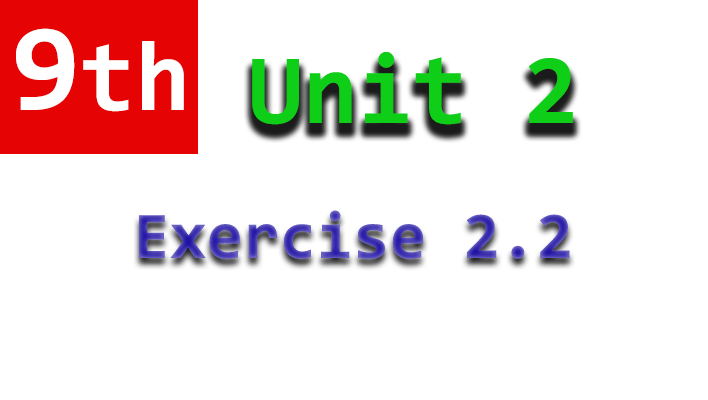- Chapter No.1 Introduction to Biology
- Chapter No. 2 Solving a Biological Problem
- Chapter No.3 Biodiversity
- Chapter No.4 Cells and Tissues
- Chapter No.5 Cell Cycle
Q.1 Identify the property used in the following;
(i) a + b = b + a (ii) (ab) * c = a(bc) (iii) 7 * 1 = 7 (v) ab = ba (vii) 5+(-5)=0 (iv) x > y or x = y or x < y (vi) a + c =b+c Rightarrow a=b (viii) 7 * 1/7 = 1 (ix) a>b Rightarrow ac > bc (c > 0)
Solution:
Let’s identify the properties used in each of the given algebraic equations:
(i) a + b = b + a – Commutative Property of Addition
Explanation: This property states that the order of adding two numbers does not affect the result.
(ii) (ab) * c = a(bc) – Associative Property of Multiplication
Explanation: This property states that the grouping of factors in a multiplication operation does not affect the result.
(iii) 7 * 1 = 7 – Multiplicative Identity Property
Explanation: The product of any number and 1 is equal to the number itself.
(v) ab = ba – Commutative Property of Multiplication
Explanation: This property states that the order of multiplying two numbers does not affect the result.
(vii) 5 + (-5) = 0 – Additive Inverse Property
Explanation: The additive inverse of a number “a” is the number that, when added to “a,” gives 0.
(iv) x > y or x = y or x < y – Law of Trichotomy Explanation: In any order relation (like greater than, less than, or equal to), any two numbers are related in one of these three ways: x > y, x = y, or x < y.
(vi) a + c = b + c ⟹ a = b – Addition Property of Equality
Explanation: This property states that if the same value is added to both sides of an equation, the equation remains true, and the two sides are still equal.
(viii) 7 * 1/7 = 1 – Multiplicative Inverse Property
Explanation: The multiplicative inverse (or reciprocal) of a non-zero number “a” is 1/a. The product of a number and its multiplicative inverse is always 1.
(ix) a > b ⟹ ac > bc (c > 0) – Multiplication Property of Inequality
Explanation: If “a” is greater than “b,” and “c” is a positive number, then the product “ac” is greater than the product “bc.”
In summary:
(i) Commutative Property of Addition
(ii) Associative Property of Multiplication
(iii) Multiplicative Identity Property
(v) Commutative Property of Multiplication
(vii) Additive Inverse Property
(iv) Law of Trichotomy
(vi) Addition Property of Equality
(viii) Multiplicative Inverse Property
(ix) Multiplication Property of Inequality
Q.2 Fill in the following blanks by stating the properties of real numbers used.
3x + 3(y – x)
= 3x + 3y – 3x ,…….
= 3x – 3x + 3y ,……..
= 0 + 3y,……….
= 3y,……..
Solution:
Let’s fill in the blanks and state the properties of real numbers used in each step:
3x + 3(y – x)
= 3x + 3y – 3x ,…… [Distributive Property]
Explanation: In this step, we use the distributive property, which states that multiplying a number by the sum of two other numbers is the same as multiplying the number by each of the two numbers and then adding the results.
= 3x – 3x + 3y ,…… [Additive Inverse Property]
Explanation: We can combine the “3x” and “-3x” terms since the additive inverse of a number is the number that, when added to the original number, gives zero.
= 0 + 3y,…… [Additive Inverse Property]
Explanation: Here, we simplify the expression “3x – 3x” to zero, using the additive inverse property.
= 3y,…… [Additive Identity Property]
Explanation: The additive identity property states that the sum of any number and zero is the number itself. Thus, “0 + 3y” is equal to “3y.”
In summary:
Distributive Property
Additive Inverse Property
Additive Identity Property
These properties of real numbers are applied step by step to simplify the given expression, leading to the final result of “3y.”
Q.3 Give the name of property used in the following.
(i) sqrt(24) + 0 = sqrt(24)
(ii) – 2/3 * (5 + 7/2) = (- 2/3)(5) + (- 2/3)(7/2)
(iii) pi + (- pi) = 0
(iv) sqrt(3) * sqrt(3) is a real number
(v) (- 5/8)(- 8/5) = 1
Solution:
Let’s give the name of the property used in each of the given expressions:
(i) √24 + 0 = √24 – Additive Identity Property
Explanation: The additive identity property states that the sum of any number and zero is the number itself.
(ii) -2/3 * (5 + 7/2) = (-2/3)(5) + (-2/3)(7/2) – Distributive Property
Explanation: The distributive property states that multiplying a number by the sum of two other numbers is the same as multiplying the number by each of the two numbers and then adding the results.
(iii) π + (-π) = 0 – Additive Inverse Property
Explanation: The additive inverse property states that the sum of a number and its additive inverse (negative) is zero.
(iv) √3 * √3 is a real number – Closure Property of Multiplication
Explanation: The closure property of multiplication states that the product of any two real numbers is always a real number.
(v) (-5/8)(-8/5) = 1 – Multiplicative Inverse Property
Explanation: The multiplicative inverse property states that the product of a number and its multiplicative inverse (reciprocal) is 1. In this case, (-5/8) and (-8/5) are reciprocals of each other.
In summary:
(i) Additive Identity Property
(ii) Distributive Property
(iii) Additive Inverse Property
(iv) Closure Property of Multiplication
(v) Multiplicative Inverse Property

